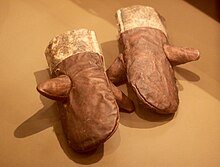Kayak glove


A kayak glove ( greenl . : Qajartormermik aaqqatit or qajartuutit ) is a mitt with two thumbs on the opposite sides, which is worn when kayaking . From a distance, the glove with the "superfluous" thumb looks as if it was put on the wrong way round.
designation
In the Greenlandic language kayak gloves are called "Qajartormermik aaqqatit" [ qaja'do'næ'mek a: 'qa'tet ], which means something like "gloves for kayaking" (Greenlandic: aaqqat = glove; plural: aaqqatit). Another name is "Qajartuutit" [ qa'ja (r) 'do:' tet ], which means "tools (equipment) for kayaking". Other terms that may be found for kayak gloves are “maattaalit” and “matât”, which probably come from an East Greenland language form. The Yupik Eskimos call kayak gloves "arilluuk".
use
In Greenland, kayak gloves were an essential part of kayaking equipment as many Greenland Inuit were kayak hunters. Besides the kayak gloves (aaqqatit, English kayak mittens ) there were special kayak sleeves (aaqqat, English kayak sleeves ).
During long kayaking trips, the hand can be turned around in the glove from time to time if the palm of the hand is soaked and becomes slippery from water or ice. So the drier back of the hand side of the glove can be made the palm side. When the wet glove is rotated, the wet surface is on top. The water freezes to a thin layer of ice, but this can be knocked off. Not only the wet palm on the glove becomes a problem when using the paddle and the harpoon, but especially the wet thumb - therefore the glove thumb is duplicated. The mittens also don't wear out as quickly because the sides change. At least the pair shown here is cut in such a way that you cannot switch gloves from one hand to the other, but only turn them around. Since the gloves are relatively large, they can also be used for an Eskimo roll without a paddle if necessary .
Materials and manufacture
The kayak glove is cut wide because it is put on together with an inner glove. The Eskimos used to use either cotton gloves or wood shavings as inner gloves for additional thermal insulation. Traditional materials for making kayak gloves were salmon skin , seal skin (identical to seal skin), or wool . Seal skin for kayak gloves was often made in a special way. The hair was not plucked, as was the case with other parts of the Eskimo kayak clothing, but shaved off. This kept the fur more grippy, even when it got damp. In addition, the inside of the seal skin has been treated with blood so that it is even better waterproof and even more supple. Kayaking gloves were also enthaartem harp seals made -Fell. They were sewn with seal esophagus. This is very suitable because it expands when wet and therefore completely fills the holes made by the sewing needle and is watertight. Today synthetic fiber yarns are used for this, since almost no thread is made from seal esophagus any more.
Traditional kayak gloves were made for personal use. They are not commercially available in Greenland today.
In Greenland's kayak clubs, traditional kayak gloves are almost only worn at championships, otherwise neoprene gloves are preferred, which are warmer, less stiff and also require less maintenance. These modern neoprene gloves are shaped to follow the sharp curvature of the fingers holding the kayak paddle.
Kayak gloves made of seal leather, Greenland 1894 (in the Linden Museum , Stuttgart)
source
- Birgitta Huse (Ed.): From head to toe. A handbook about body, clothing and jewelry for intercultural teaching practice (= counter images 4). Waxmann-Verlag, Münster et al. 2004, ISBN 3-8309-1421-0 , p. 210.
- Keld Hansen: Nuussuarmiut - Hunting Families on the Big Headland. Demography, Subsistence and Material Culture in Nuussuaq, Upernavik, Northwest Greenland (= Meddelelser om Grønland. Man & society 35). Commission for Scientific Research in Greenland, Copenhagen 2008, ISBN 978-87-635-1084-4 , p. 138.



